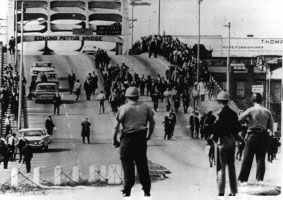Selma to Montgomery marches
Selma to Montgomery Marches
The Selma to Montgomery marches were pivotal events in the American civil rights movement, held in 1965. These marches were organized to demonstrate the desire of African-American citizens to exercise their constitutional right to vote, in defiance of segregationist repression. The marches were a catalyst for the passage of the Voting Rights Act of 1965, a landmark piece of federal legislation in the United States that prohibits racial discrimination in voting.
Background[edit | edit source]
The Selma to Montgomery marches were part of a broader voting rights movement in Selma, Alabama, launched by local African-American leaders who were frustrated by the systemic exclusion of black voters from the electoral process. Despite the constitutional right to vote, African-Americans in the South faced numerous obstacles, including literacy tests, poll taxes, and outright intimidation.
The Southern Christian Leadership Conference (SCLC), led by Dr. Martin Luther King Jr., and the Student Nonviolent Coordinating Committee (SNCC) were instrumental in organizing the marches. The first march took place on March 7, 1965, a day that would become known as "Bloody Sunday."
Bloody Sunday[edit | edit source]
On March 7, 1965, approximately 600 civil rights marchers departed Selma, heading east on U.S. Route 80. The marchers were led by John Lewis of SNCC and Reverend Hosea Williams of SCLC. As they crossed the Edmund Pettus Bridge, they were met by Alabama state troopers and local law enforcement who ordered them to disperse. When the marchers refused, they were brutally attacked with billy clubs and tear gas, resulting in numerous injuries. The violence was broadcast on national television, shocking the nation and garnering widespread support for the civil rights movement.
Turnaround Tuesday[edit | edit source]
In response to the events of Bloody Sunday, Dr. Martin Luther King Jr. called for a second march. On March 9, 1965, King led a group of marchers to the Edmund Pettus Bridge, where they knelt in prayer before turning back, in compliance with a court order. This event became known as "Turnaround Tuesday."
The Third March[edit | edit source]
The third march began on March 21, 1965, after a federal court order permitted the march to proceed. Under the protection of federal forces, including the National Guard, approximately 3,200 marchers set out from Selma. Over the course of five days, the marchers covered the 54-mile route to Montgomery, growing in number to an estimated 25,000 by the time they reached the Alabama State Capitol on March 25.
Impact and Legacy[edit | edit source]
The Selma to Montgomery marches were instrumental in raising awareness of the struggle for voting rights and led directly to the passage of the Voting Rights Act of 1965. This legislation was a significant victory for the civil rights movement, as it outlawed discriminatory voting practices that had been responsible for the widespread disenfranchisement of African-Americans.
The marches also highlighted the power of nonviolent protest and the importance of media coverage in advancing civil rights. The events in Selma galvanized public opinion and increased support for the civil rights movement across the United States.
Also see[edit | edit source]
- Civil Rights Movement
- Voting Rights Act of 1965
- Martin Luther King Jr.
- Edmund Pettus Bridge
- John Lewis
Lua error in package.lua at line 80: module 'strict' not found.
Search WikiMD
Ad.Tired of being Overweight? Try W8MD's physician weight loss program.
Semaglutide (Ozempic / Wegovy and Tirzepatide (Mounjaro / Zepbound) available.
Advertise on WikiMD
|
WikiMD's Wellness Encyclopedia |
| Let Food Be Thy Medicine Medicine Thy Food - Hippocrates |
Translate this page: - East Asian
中文,
日本,
한국어,
South Asian
हिन्दी,
தமிழ்,
తెలుగు,
Urdu,
ಕನ್ನಡ,
Southeast Asian
Indonesian,
Vietnamese,
Thai,
မြန်မာဘာသာ,
বাংলা
European
español,
Deutsch,
français,
Greek,
português do Brasil,
polski,
română,
русский,
Nederlands,
norsk,
svenska,
suomi,
Italian
Middle Eastern & African
عربى,
Turkish,
Persian,
Hebrew,
Afrikaans,
isiZulu,
Kiswahili,
Other
Bulgarian,
Hungarian,
Czech,
Swedish,
മലയാളം,
मराठी,
ਪੰਜਾਬੀ,
ગુજરાતી,
Portuguese,
Ukrainian
Medical Disclaimer: WikiMD is not a substitute for professional medical advice. The information on WikiMD is provided as an information resource only, may be incorrect, outdated or misleading, and is not to be used or relied on for any diagnostic or treatment purposes. Please consult your health care provider before making any healthcare decisions or for guidance about a specific medical condition. WikiMD expressly disclaims responsibility, and shall have no liability, for any damages, loss, injury, or liability whatsoever suffered as a result of your reliance on the information contained in this site. By visiting this site you agree to the foregoing terms and conditions, which may from time to time be changed or supplemented by WikiMD. If you do not agree to the foregoing terms and conditions, you should not enter or use this site. See full disclaimer.
Credits:Most images are courtesy of Wikimedia commons, and templates, categories Wikipedia, licensed under CC BY SA or similar.
Contributors: Prab R. Tumpati, MD



